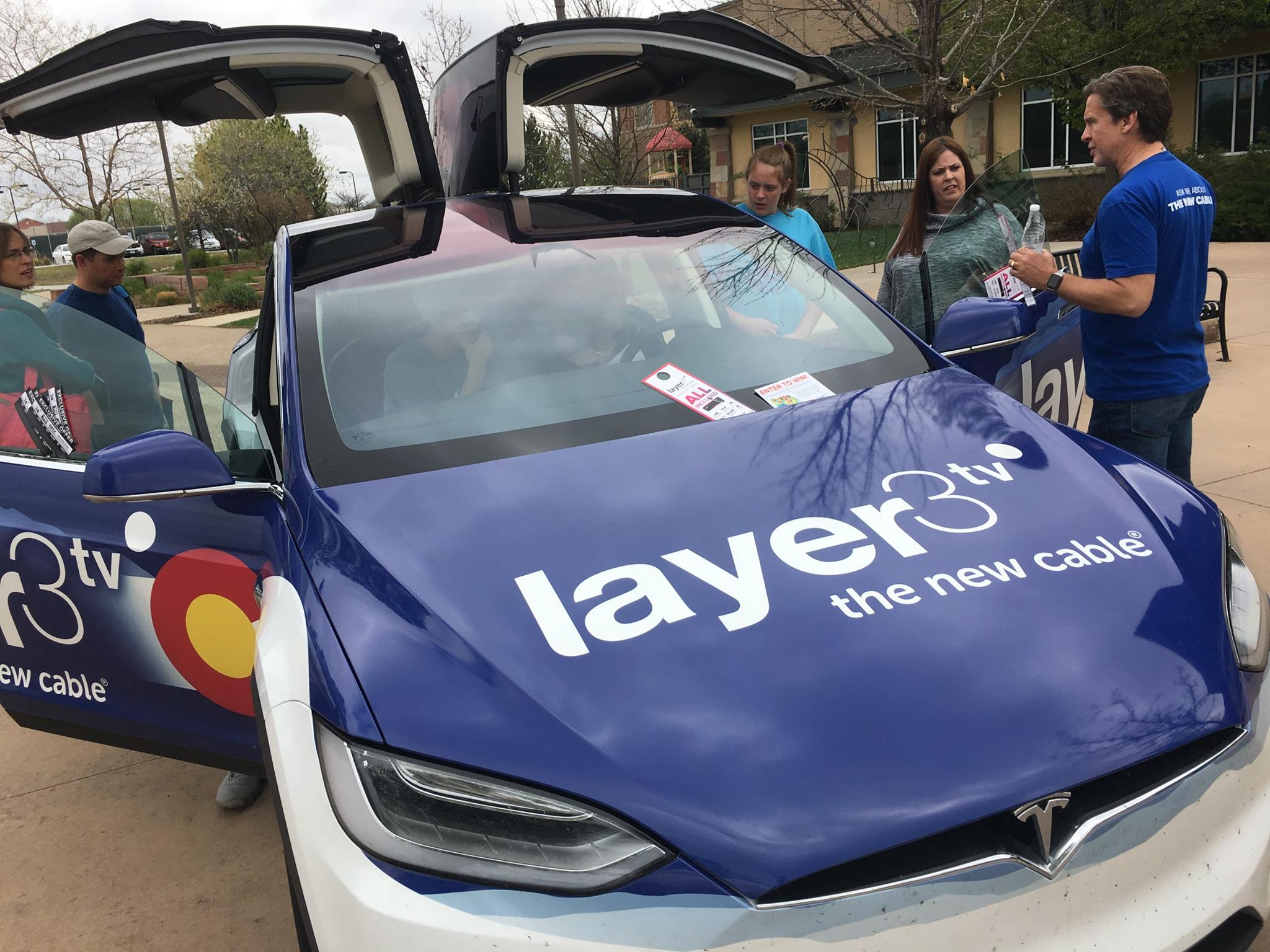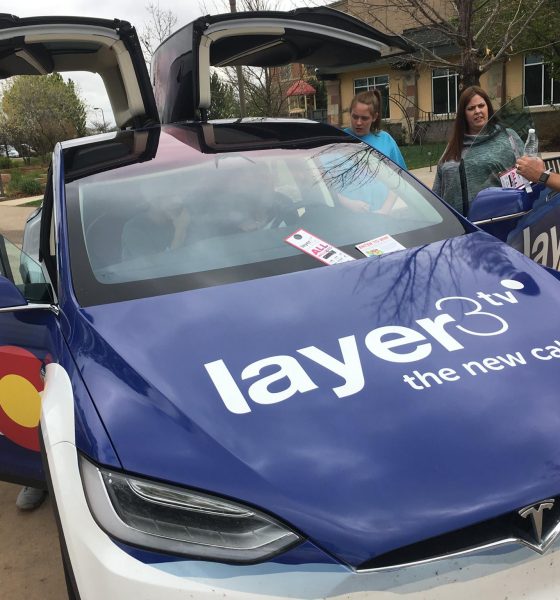

News
Layer3 TV plans to use 100 Tesla Model X fleet to deliver next-gen cable
Denver-based Layer3 TV, a next generation cable television service provider, is switching its service vehicles to a Tesla Model X fleet as the company aims to redefine the antiquated cable TV industry using modern day technologies. Layer3’s CEO Jeff Binder said that the company’s biggest advantage is in video quality, citing “It’s unanimous”.
With plans to purchase 100 Model X vehicles by the end of the year, Binder claims that the savings from their unique installation process and the low maintenance cost of the Model X enables the company to reap “substantial” savings. Their installation costs are nearly 50% lower than competitors, enabling the company to expand the Model X fleet and creating a “win-win” scenario.
“It’s a pretty different experience… Who doesn’t like driving a Model X?” – Layer3 TV CEO Jeff Binder
The company, founded in 2013 by cable veterans Jeff Binder and Dave Fellows, raised nearly $100M to fund its big plans to disrupt the cable service provider industry. Layer3 TV tells Teslarati that they had purchased a Model X to deliver their new service in Colorado earlier this year, and recently expanded the fleet nationwide. Layer3 currently services Chicago, Washington DC, Los Angeles, Dallas, and parts of Denver. While Binder didn’t release any subscriber numbers, he said the company is seeing double digit growth month-over-month.

Layer3 Originally planned to have a fleet of BMW i3s, but ultimately decided the Model X better fit their needs.
Multichannel reported that Layer3 TV is using a fleet of Teslas for their Colorado rollout stating, “For the rollout with NextLight in Longmont, Layer3 TV is using a fleet of Tesla vehicles to perform installs and other customer visits.” Layer3 TV initially envisioned using a fleet of BMW i3s but decided to go with the Tesla Model X after determining that they needed more space, all wheel drive, and more range.
The company plans to have a fleet of roughly 100 Teslas by the end of the year and currently has the Model X deployed in all of their markets. Jeff Binder told Teslarati via phone, “There is no downside… we are spending half as much as the competition on installs, our installers love the vehicles, it’s sustainable, and we get great marketing out of the vehicles.”
100 Tesla Model X Fleet
Layer3’s fleet of Model Xs are presumably the largest in the world, as not many company’s have adopted commercial uses for the vehicle. Binder told Teslarati that they haven’t adopted any custom fleet management systems in the Model X that’s out of the norm, but definitely plans to take advantage of the Model X’s large center screen. Binder is a bit surprised that Tesla doesn’t have much of a fleet management system, and hopes the company will develop such a program.

Layer3 has deployed their fleet nationwide, and plans to continue adding more vehicles to the fleet. Photo: Layer3 TV
Layer3 stated back in March, “Not only do we provide quick installs, but we do it in a Tesla. Rodney (a Layer3 TV installer) installs 6 boxes in a day with our eco-friendly Tesla.”
Before the company launched their service last year they had planned to deliver the service in the BMW i3. Layer3 is aiming to be the new “upscale” cable provider, while the company doesn’t lay its own fiber or cable lines, it delivers the service through advanced video technology riding through leased fiber and private IP. You can see if Layer3 TV is in available in your area.

Picking the Tesla Model X looks like the perfect way to show customers that they aren’t doing business in the usual way which stereotypically includes late arrivals and in a beat-up white van.
The nex-gen cable TV provider has released a video showing off their new wrap which we find simply stunning. Check out the video below to see how Layer3 TV “tricked out” their Model X!
https://www.facebook.com/inkmonstr/videos/1504959446214814/
https://instagram.com/p/BSv8UHOgGQ9/

News
Tesla FSD fleet is nearing 7 billion total miles, including 2.5 billion city miles
As can be seen on Tesla’s official FSD webpage, vehicles equipped with the system have now navigated over 6.99 billion miles.

Tesla’s Full Self-Driving (Supervised) fleet is closing in on almost 7 billion total miles driven, as per data posted by the company on its official FSD webpage.
These figures hint at the massive scale of data fueling Tesla’s rapid FSD improvements, which have been quite notable as of late.
FSD mileage milestones
As can be seen on Tesla’s official FSD webpage, vehicles equipped with the system have now navigated over 6.99 billion miles. Tesla owner and avid FSD tester Whole Mars Catalog also shared a screenshot indicating that from the nearly 7 billion miles traveled by the FSD fleet, more than 2.5 billion miles were driven inside cities.
City miles are particularly valuable for complex urban scenarios like unprotected turns, pedestrian interactions, and traffic lights. This is also the difference-maker for FSD, as only complex solutions, such as Waymo’s self-driving taxis, operate similarly on inner-city streets. And even then, incidents such as the San Francisco blackouts have proven challenging for sensor-rich vehicles like Waymos.
Tesla’s data edge
Tesla has a number of advantages in the autonomous vehicle sector, one of which is the size of its fleet and the number of vehicles training FSD on real-world roads. Tesla’s nearly 7 billion FSD miles then allow the company to roll out updates that make its vehicles behave like they are being driven by experienced drivers, even if they are operating on their own.
So notable are Tesla’s improvements to FSD that NVIDIA Director of Robotics Jim Fan, after experiencing FSD v14, noted that the system is the first AI that passes what he described as a “Physical Turing Test.”
“Despite knowing exactly how robot learning works, I still find it magical watching the steering wheel turn by itself. First it feels surreal, next it becomes routine. Then, like the smartphone, taking it away actively hurts. This is how humanity gets rewired and glued to god-like technologies,” Fan wrote in a post on X.
News
Tesla starts showing how FSD will change lives in Europe
Local officials tested the system on narrow country roads and were impressed by FSD’s smooth, human-like driving, with some calling the service a game-changer for everyday life in areas that are far from urban centers.

Tesla has launched Europe’s first public shuttle service using Full Self-Driving (Supervised) in the rural Eifelkreis Bitburg-Prüm region of Germany, demonstrating how the technology can restore independence and mobility for people who struggle with limited transport options.
Local officials tested the system on narrow country roads and were impressed by FSD’s smooth, human-like driving, with some calling the service a game-changer for everyday life in areas that are far from urban centers.
Officials see real impact on rural residents
Arzfeld Mayor Johannes Kuhl and District Administrator Andreas Kruppert personally tested the Tesla shuttle service. This allowed them to see just how well FSD navigated winding lanes and rural roads confidently. Kruppert said, “Autonomous driving sounds like science fiction to many, but we simply see here that it works totally well in rural regions too.” Kuhl, for his part, also noted that FSD “feels like a very experienced driver.”
The pilot complements the area’s “Citizen Bus” program, which provides on-demand rides for elderly residents who can no longer drive themselves. Tesla Europe shared a video of a demonstration of the service, highlighting how FSD gives people their freedom back, even in places where public transport is not as prevalent.
What the Ministry for Economic Affairs and Transport says
Rhineland-Palatinate’s Minister Daniela Schmitt supported the project, praising the collaboration that made this “first of its kind in Europe” possible. As per the ministry, the rural rollout for the service shows FSD’s potential beyond major cities, and it delivers tangible benefits like grocery runs, doctor visits, and social connections for isolated residents.
“Reliable and flexible mobility is especially vital in rural areas. With the launch of a shuttle service using self-driving vehicles (FSD supervised) by Tesla in the Eifelkreis Bitburg-Prüm, an innovative pilot project is now getting underway that complements local community bus services. It is the first project of its kind in Europe.
“The result is a real gain for rural mobility: greater accessibility, more flexibility and tangible benefits for everyday life. A strong signal for innovation, cooperation and future-oriented mobility beyond urban centers,” the ministry wrote in a LinkedIn post.
News
Tesla China quietly posts Robotaxi-related job listing
Tesla China is currently seeking a Low Voltage Electrical Engineer to work on circuit board design for the company’s autonomous vehicles.

Tesla has posted a new job listing in Shanghai explicitly tied to its Robotaxi program, fueling speculation that the company is preparing to launch its dedicated autonomous ride-hailing service in China.
As noted in the listing, Tesla China is currently seeking a Low Voltage Electrical Engineer to work on circuit board design for the company’s autonomous vehicles.
Robotaxi-specific role
The listing, which was shared on social media platform X by industry watcher @tslaming, suggested that Tesla China is looking to fill the role urgently. The job listing itself specifically mentions that the person hired for the role will be working on the Low Voltage Hardware team, which would design the circuit boards that would serve as the nervous system of the Robotaxi.
Key tasks for the role, as indicated in the job listing, include collaboration with PCB layout, firmware, mechanical, program management, and validation teams, among other responsibilities. The role is based in Shanghai.
China Robotaxi launch
China represents a massive potential market for robotaxis, with its dense urban centers and supportive policies in select cities. Tesla has limited permission to roll out FSD in the country, though despite this, its vehicles have been hailed as among the best in the market when it comes to autonomous features. So far, at least, it appears that China supports Tesla’s FSD and Robotaxi rollout.
This was hinted at in November, when Tesla brought the Cybercab to the 8th China International Import Expo (CIIE) in Shanghai, marking the first time that the autonomous two-seater was brought to the Asia-Pacific region. The vehicle, despite not having a release date in China, received a significant amount of interest among the event’s attendees.








